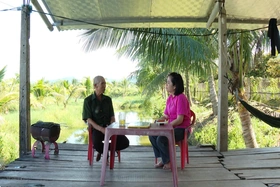{title}
{publish}
{head}
Quang Tri’s Department of Forest Protection over the past time has worked closely with relevant agencies to implement a range of measures aimed at effectively preventing illegal hunting, trading, transportation, and use of wildlife.

The launch of a campaign raising public awareness of protecting wildlife held in Quang Tri in 2024. Photo: H.T
The province has placed strong emphasis on conserving and enhancing natural resources and biodiversity in the locality of more than 126,000 ha of natural forests and dozens of rare flora and fauna species.
Scientists and international organizations have recognized Quang Tri as one of the provinces with high biodiversity in Vietnam. Its flora and fauna are rich and diverse, with over 110 mammal species, nearly 200 bird species, 83 species of amphibians and reptiles, more than 336 species of fish, and approximately 2,000 plant species. Many of these are endemic, endangered, and rare, including the Edwards’s pheasant (Lophura edwardsi), saola (Pseudoryx nghetinhensis), gaur, large-antlered muntjac, and rare plants such as conifer species, slipper orchids, and agarwood.
However, the degradation of biodiversity has been ongoing, with many rare and valuable wildlife species now endangered or facing extinction. In response, the province has prioritized the development and planning of biodiversity conservation initiatives to conserve resources sustainably, to support socio-economic development, and environmental protection.
These efforts align with national and local policies and contribute to the provincial Forestry Development Strategy for 2021–2030, with a vision to 2050. Additionally, it has strengthened communication and legal and financial frameworks.
To date, the province has established three nature reserves, two landscape protection forests, and one biodiversity corridor connecting the Dakrong and Bac Huong Hoa Nature Reserves to preserve biodiversity resources, especially endemic, endangered, and rare plant and animal species.
Notably, the Bac Huong Hoa Nature Reserve spans more than 23,456 hectares and is the only area in Vietnam that includes both the eastern and western sides of the Truong Son Mountain Range, with peaks over 1,000 meters and over 90% forest coverage. It covers five communes (Huong Phung, Huong Linh, Huong Son, Huong Viet, and Huong Lap) in Huong Hoa District.
This region is home to species of global conservation significance, with 11 species listed on the IUCN Red List, including five critically endangered species: the Hatinh langur, red-shanked douc, northern white-cheeked gibbon, Asiatic black bear, and saola; and six vulnerable species: Javan pangolin, Assamese macaque, smooth-coated otter, large-antlered muntjac, gaur, and serow.
The Dakrong Nature Reserve, covering over 37,000 hectares across seven communes (Dakrong, Trieu Nguyen, Ba Long, Huc Nghi, Ba Nang, Ta Long, and A Bung) also features rich biodiversity, with nearly 1,500 vascular plant species, 91 mammal species, 193 bird species, 49 reptile and amphibian species, and 72 fish species.
Under the direction of the Provincial People’s Committee and the Department of Agriculture and Environment, the provincial forest rangers coordinate annually with forest management boards and local authorities to conduct patrols to prevent activities that threaten forests and biodiversity.
These efforts have enabled local authorities to detect and handle many wildlife hunting cases, the remove of animal traps, improved forest protection, and safer conditions for wildlife. Public awareness campaigns have been intensified, especially targeting ethnic minority communities and residents living near forests, encouraging their involvement in biodiversity conservation.
Meanwhile, public outreach becomes increasingly effective, with many individuals and households voluntarily handing over captive wild animals to forest rangers for release into the wild, significantly aiding conservation efforts.
At the same time, nature reserves have launched various programs to protect the species under their care, particularly those endangered and rare. Over the years, they have conducted numerous biodiversity surveys through different projects to develop proper conservation plans.
Van Ngoc Thang, Deputy Director of the Provincial Forest Protection Department, said the agency is committed to identifying, preventing, and handling legal violations related to wildlife protection, especially concerning endangered, rare, and CITES-listed species, in accordance with directives from the national Forest Protection Department and the Department of Agriculture and Environment.
In addition, the Department of Forest Protection will require local ranger stations to coordinate with relevant agencies and local authorities to raise public awareness of wildlife protection laws, particularly for businesses and wildlife breeding facilities. Rangers will also step up patrols and engage communities to avoid illegal hunting, trapping, trading, transporting, or consuming wildlife, especially rare and endangered species, and to actively report violations.
Authorities will seek formal commitments from restaurants and food establishments not to purchase, sell, cook, consume, or store wild animals.
Another effort includes the cooperation between the Mobile Forest Ranger Team and the Forest Fire Prevention Division in stepping up patrols to deal with illegal activities, such as hunting, killing, raising, trading, transporting, and storing wild animals. The illegal activities are normally reported along key routes and border areas between Vietnam and Laos, particularly near the Lao Bao and La Lay International Border Gates, and along the Ho Chi Minh Road and National Highway 9.
The Forest Protection Department will also work with relevant agencies to shut down illegal wildlife markets and trading hotspots, especially those involving endangered and rare species.
Thu Ha – Linh Pham

QTO - Not letting summer slip by in vain, many students in Quang Tri have taken the initiative to teach English to younger children. Through each lesson,...

QTO - Returning from the northern border front with a 2/4 disability, it seemed his journey of service had come to an end. Yet, this wounded soldier began...